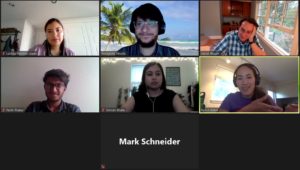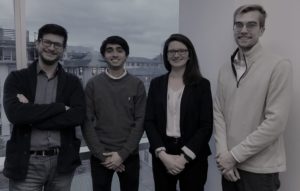Last updated Aug. 2021
In the summer of 2020, Simran Bhalla (EST&P 2020, currently at ICF), Mark Schneider (Tepper 2020, currently with Clearway Community Energy) & Parth Thakar (EST&P 2020, currently at Enphase Energy) worked to determine the challenges in expanding and reinforcing the transmission system in the US. The electricity infrastructure, especially at the levels of higher voltages, is ageing in the sense that loads have been historically increasing, while, more recently and due to distributed generation, the concerns for bidirectional power flows need to be accounted for. The complicated regulatory framework and NIMBYism, however, have been delaying – many times to a complete halt – dozens of such projects. This group attempted to sort through the mess and make suggestions along multiple directions for the case of the US electrical grid.

Simran, Mark & Parth presenting their research results to faculty & thought leaders in the field.
 Uday Sriram (ECE 2020, currently at DiGioia Gray) has tested a method for the detection of a forest fire at the proximity of an overhead conductor. The aim is for the power line to be disconnected just-in-time once the fire is detected and not preemptively. Preemptive disconnections of overhead conductors are a typical practice during heatwaves, in order to avoid the break-out of new fires, nevertheless it is a practice of high social cost.
Uday Sriram (ECE 2020, currently at DiGioia Gray) has tested a method for the detection of a forest fire at the proximity of an overhead conductor. The aim is for the power line to be disconnected just-in-time once the fire is detected and not preemptively. Preemptive disconnections of overhead conductors are a typical practice during heatwaves, in order to avoid the break-out of new fires, nevertheless it is a practice of high social cost.
 Parth Thakar (EST&P 2020, currently at Enphase Energy) worked with me also on coding and testing a solution to the Alternating Current Optimal Power Flow (AC OPF) using top-down heuristically inducted binary decision trees. The non-convex nature of the problem makes it challenging to solve in actionable times, while the solution itself might not be globally optimum. Using machine learning as a solver can at the very least offer a different perspective to this fundamental power system problem.
Parth Thakar (EST&P 2020, currently at Enphase Energy) worked with me also on coding and testing a solution to the Alternating Current Optimal Power Flow (AC OPF) using top-down heuristically inducted binary decision trees. The non-convex nature of the problem makes it challenging to solve in actionable times, while the solution itself might not be globally optimum. Using machine learning as a solver can at the very least offer a different perspective to this fundamental power system problem.
 Radhika Lampuse (EST&P 2020, currently at Oriden Power) worked on identifying what economic damage is accumulated, if any single data-point or variable of the day-ahead market scheduling is erroneous and goes unnoticed for long times. The error might be caused either by a cyber-security attack or plainly mistyping a parameter. The research was inspired by the ‘fictitious’ or ‘phantom’ demand in the Ontario electricity market, which was not detected for months and cost dozens of millions of dollars.
Radhika Lampuse (EST&P 2020, currently at Oriden Power) worked on identifying what economic damage is accumulated, if any single data-point or variable of the day-ahead market scheduling is erroneous and goes unnoticed for long times. The error might be caused either by a cyber-security attack or plainly mistyping a parameter. The research was inspired by the ‘fictitious’ or ‘phantom’ demand in the Ontario electricity market, which was not detected for months and cost dozens of millions of dollars.
Kristina Nikiforova (Tepper 2021, currently at National Grid), Matt Griffin (Tepper 2021, currently at Target) and Ansh Nasta (EST&P 2019, currently at The Energy Futures Initiative) qualified for the finals of the Net Impact Future of Energy in Mobility Challenge. They proposed the idea of a two-pronged start-up that would (i) strategically deploy electric vehicle charging stations in remote and rural communities, combined with (ii) a pooling and charging queueing mobile application for efficient and secure evacuations during emergencies. You can watch the pitch here.

R-L: Matt, Kristina, Ansh and I, in Dec. 2019, after we have just been awarded the qualification for the finals.